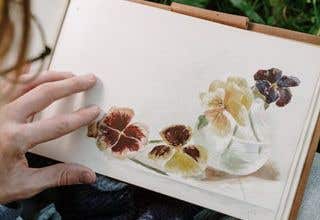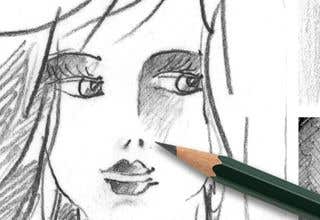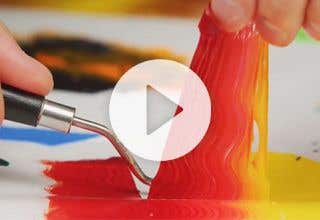We know that getting started on your painting journey can come with what feels like a whole new language to learn. With so many ways you can use paint, and the wide range of properties they possess, it can feel a little overwhelming - but it doesn’t have to be! Our Eckersley’s artists have come together to create this glossary of basic painting terms to help guide you through buying and using your first set of paints.
Whether you’re looking to get started with watercolours, dip your toes into the world of acrylics, or dive right into oil painting, these painting terms are good to know before you take the plunge

Blending
In painting, blending is used to describe transitioning gradually from one colour into another. This effect is best created when the paint is still wet, as painting smooth transitions once one paint has dried can be very difficult.
Durability
You will often read about the durability of paint, but it can be defined differently by different brands or people! At its core, a paint’s durability relates to how well it will hold up against cracking, fading, and scratches.
Highlight
The highlight in an artwork relates to the lightest tones within it. Often, to create a highlight, artists will add a white tone on top of existing colours.
Hue
When the term ‘hue’ is used in a paint colour, it indicates that the colour is a mix of other colours rather than being made from a single, pure pigment.
Gesso
Gesso is similar to a very thin acrylic paint. It is useful in preparing (or ‘priming’) a canvas, as gesso dries hard and will make the surface stiffer and slightly textured.
Traditionally, gesso is white, however you can also find it in clear, black, or coloured forms. To tint your own gesso, you can mix a small amount of acrylic paint to a white or clear gesso.
Lightfastness
The lightfastness of a paint refers to how well it resists fading or colour bleaching when exposed to light.
Medium
You’ll often see the term ‘medium’ in painting, as it refers to anything you are drawing or painting with (such as acrylic paint, oil paint, charcoal, etc.). It can also mean anything you mix with a paint in order to change the consistency of it, such as water or glazing liquids!
Mixed Media
Mixed media artworks refer to when different mediums are used to create a single piece of art. For example, artists could use both acrylic paint and charcoal to create an artwork.
It also encompasses artists using less traditional media in their artworks such as adding textile pieces to a painting, or natural elements like bark or straw.
Opacity
The opacity of a paint refers to how much light it will let through. A more opaque paint will have pigments that don’t let light through, whereas transparent paints will let more light through!
The opacity of a paint will depend on the ingredients and pigments it’s made from. You can often find swatch images of paints (either online or on the tubes) that help indicate their opacity.
Open time
The open time of a paint describes how long it will stay wet enough to work with. The open time of a paint can be altered using certain chemicals.
Pigment
Pigment is the raw material paints are made from. They can be made of natural or synthetic materials which are finely ground then mixed with a binder to create paint.
The various properties of a paint, such as lightfastness, opacity, and durability, will depend on which raw ingredients and pigments are used to create it.
Permanence
The permanence of a paint reflects how resilient the paint is, and how it will hold up over time. Some paints are more resistant to light & atmosphere changes than others, making them more permanent.
Permanence ratings can be reflected in numbers or letters, with AA, 1 or I being the most permanent.
Series
While looking for new paints, you may have come across series numbers on the tubes or in the product names. The series numbers reflect the cost of pigments and raw materials used to produce the paint, so you won’t find a colour across multiple series!
Due to the series being based on pigments and materials of the paint, they are also often priced relatively, with Series 1 being the cheaper paints to produce. This isn’t necessarily a reflection on quality of paint, though higher series may be made with more pure pigments.
Shade
Shade is where an artist has darkened a hue or colour by mixing it with black.
Tint
A tint is where an artist has lightened a colour with white to desaturate it. Tints are sometimes referred to as pastel colours. For example, pink is a tint artists create by adding white to red paints.
Tinting Strength
The tinting strength of a paint will tell artists how much a colour will be altered by adding white or another colour. A high tinting strength in a paint means it will hold its colour more strongly, therefore requiring a lot of a second colour to alter it.
Tinting strength of a paint is determined by the quality, amount, and coarseness of the pigment it’s made from.
Tone
The tone of an artwork refers to the levels of light and dark contained. The base tones are the darkest elements of your artwork, following half tones through to the light tones and highlights, which are the most illuminated elements.
Tooth
A canvas’s tooth relates to how coarse the surface’s weave is. A surface with a higher tooth is coarser and will help pull paint from a brush onto it, whereas smoother surfaces like paper have less tooth.
When you’re starting out, you may want to choose a surface with medium tooth and texture, as this will be suitable for a wider variety of mediums.
Transparency
As with opacity, this refers to how much light a paint will let through. Transparent colours offer the least coverage and allow light to pass through their layer to the surface or other paint layers below.
Wash
A wash is a paint that has been diluted with water to thin it. Generally, artists use washes in the early blocking stages of painting as it helps to get a sense of the colour palette.
The term ‘wash’ can also be used to refer to an area of paint where you can’t see individual strokes, generally a large area of flat colour, or with a subtle gradient of tone or colour.

We hope these explanations help you on your painting journey! Painting with any medium is such a wonderful way to express yourself, flex your creative muscles, and feel inspired. Painting also has so many benefits to your wellbeing, promoting stress relief, expanding your creative stimulation, and helps enhance your fine motor skills.
Browse our watercolour, acrylic, oil, and gouache ranges and have fun creating!
We’d love to see the artworks you create too, tag us in your posts on social media using #CreateWithEckersleys so we can celebrate your creativity!











